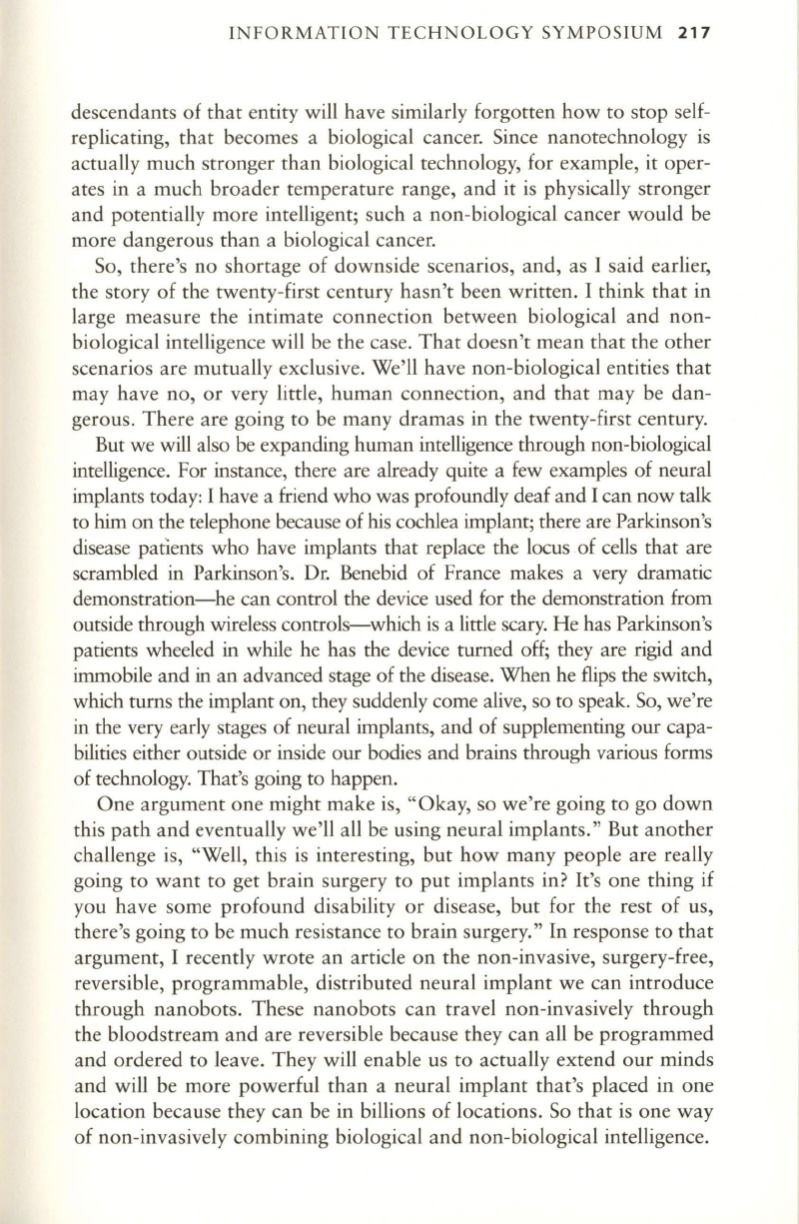
INFORMATION TECHNOLOGY SYMPOSIUM
217
descendants of that entity will have similarly forgotten how to stop self–
replicating, that becomes a biological cancer. Since nanotechnology is
actually much stronger than biological technology, for example, it oper–
ates in a much broader temperature range, and it is physically stronger
and potentially more intelligent; such a non-biological cancer would be
more dangerous than a biological cancer.
So, there's no shortage of downside scenarios, and, as I said earlier,
the story of the twenty-first century hasn't been written. I think that in
large measure the intimate connection between biological and non–
biological intelligence will be the case. That doesn't mean that the other
scenarios are mutually exclusive. We'll have non-biological entities that
may have no, or very little, human connection, and that may be dan–
gerous. There are going to be many dramas in the twenty-first century.
But we will also be expanding human intelligence through non-biological
intelligence. For instance, there are already quite a few examples of neural
implants today: I have a friend who was profoundly deaf and I can now talk
to
him
on the telephone because of his cochlea implant; there are Parkinson's
disease patients who have implants that replace the locus of cells that are
scrambled in Parkinson's. Dr. Benebid of France makes a very dramatic
demonstration-he can control the device used for the demonstration from
outside through wireless controls-which is a little scary. He has Parkinson's
patients wheeled in while he has the device turned off; they are rigid and
immobile and in an advanced stage of the disease. When he flips the switch,
which turns the implant on, they suddenly come alive, so to speak. So, we're
in the very early stages of neural implants, and of supplementing our capa–
bilities either outside or inside our bodies and brains through various forms
of technology. That's going to happen.
One argument one might make is, "Okay, so we're going to go down
this path and eventually we'll all be using neural implants." But another
challenge is, "Well, this is interesting, but how many people are really
going to want to get brain surgery to put implants in? It's one thing if
you have some profound disability or disease, but for the rest of us,
there's going to be much resistance to brain surgery." In response to that
argument, I recently wrote an article on the non-invasive, surgery-free,
reversible, programmable, distributed neural implant we can introduce
through nanobots. These nanobots can travel non-invasively through
the bloodstream and are reversible because they can all be programmed
and ordered to leave. They will enable us to actually extend our minds
and will be more powerful than a neural implant that's placed in one
location because they can be in billions of locations. So that is one way
of non-invasively combining biological and non-biological intelligence.


